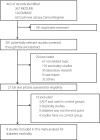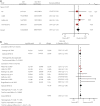Androgen deprivation therapy is associated with diabetes: Evidence from meta-analysis
- PMID: 27181717
- PMCID: PMC4931216
- DOI: 10.1111/jdi.12472
Androgen deprivation therapy is associated with diabetes: Evidence from meta-analysis
Abstract
Aims/introduction: There is still no obvious evidence proving that androgen deprivation therapy (ADT) would increase the risk of diabetes. To determine if ADT is associated with diabetes in men with prostate cancer, we carried out the present study.
Materials and methods: We systematically searched Medline, Embase and the Cochrane Library Central Register through 2014. Studies comparing ADT vs control aimed at treating prostate cancer reporting diabetes as outcome were included. Data were extracted independently by two reviewers. This meta-analysis was reported based on the Preferred Reporting Items for Systematic reviews and Meta-Analyses checklist. Observational studies were evaluated through the Meta-analysis Of Observational Studies in Epidemiology checklist.
Results: Eight studies were identified with 65,695 ADT users and 91,893 non-ADT users. The pooled incidence of diabetes was 39% higher in ADT groups. A significant association was observed in the overall analysis (risk ratio [RR] 1.39, 95% confidence interval [CI] 1.27-1.53; P < 0.001). In subgroup analyses, diabetes was found to be significantly associated with gonadotropin-releasing hormone (GnRH) alone (RR 1.45, 95% CI 1.36-1.54; P < 0.001), GnRH plus oral antiandrogen (RR 1.40, 95% CI 1.01-1.93; P = 0.04) and orchiectomy (RR 1.34, 95% CI 1.20-1.50; P < 0.001), but not with antiandrogen alone (RR 1.33, 95% CI 0.75-2.36; P = 0.33). Diabetes was strongly related to long duration of ADT (RR 1.43, 95% CI 1.22-1.68; P < 0.001), and was slightly associated with short duration of ADT (RR 1.29, 95% CI 1.12-1.49; P = 0.0004).
Conclusions: ADT, especially long duration (>6 months) of this treatment, GnRH alone, GnRH plus antiandrogen and orchiectomy can increase the incidence of diabetes.
Keywords: Androgen deprivation therapy; Diabetes; Meta-analysis.
© 2015 The Authors. Journal of Diabetes Investigation published by Asian Association for the Study of Diabetes (AASD) and John Wiley & Sons Australia, Ltd.
Figures



Similar articles
-
Stroke related to androgen deprivation therapy for prostate cancer: a meta-analysis and systematic review.BMC Cancer. 2016 Mar 3;16:180. doi: 10.1186/s12885-016-2221-5. BMC Cancer. 2016. PMID: 26940836 Free PMC article. Review.
-
Association of androgen deprivation therapy with thromboembolic events in patients with prostate cancer: a systematic review and meta-analysis.Prostate Cancer Prostatic Dis. 2018 Nov;21(4):451-460. doi: 10.1038/s41391-018-0059-4. Epub 2018 Jul 9. Prostate Cancer Prostatic Dis. 2018. PMID: 29988099
-
Quantifying observational evidence for risk of fatal and nonfatal cardiovascular disease following androgen deprivation therapy for prostate cancer: a meta-analysis.Eur Urol. 2015 Sep;68(3):386-96. doi: 10.1016/j.eururo.2014.11.039. Epub 2014 Dec 5. Eur Urol. 2015. PMID: 25484142 Review.
-
Androgen deprivation therapy for prostate cancer is associated with cardiovascular morbidity and mortality: a meta-analysis of population-based observational studies.PLoS One. 2014 Sep 29;9(9):e107516. doi: 10.1371/journal.pone.0107516. eCollection 2014. PLoS One. 2014. PMID: 25264674 Free PMC article.
-
Androgen Deprivation Therapies and Changes in Comorbidity: A Comparison of Gonadotropin-releasing Hormone Agonists and Antiandrogen Monotherapy as Primary Therapy in Men with High-risk Prostate Cancer.Eur Urol. 2019 Apr;75(4):676-683. doi: 10.1016/j.eururo.2018.11.022. Epub 2018 Nov 26. Eur Urol. 2019. PMID: 30497883
Cited by
-
Medication-Induced Hyperglycemia and Diabetes Mellitus: A Review of Current Literature and Practical Management Strategies.Diabetes Ther. 2024 Sep;15(9):2001-2025. doi: 10.1007/s13300-024-01628-0. Epub 2024 Jul 31. Diabetes Ther. 2024. PMID: 39085746 Free PMC article. Review.
-
HbA1c Variability and Cardiovascular Events in Patients with Prostate Cancer Receiving Androgen Deprivation Therapy.Eur Urol Open Sci. 2022 Dec 15;47:3-11. doi: 10.1016/j.euros.2022.11.002. eCollection 2023 Jan. Eur Urol Open Sci. 2022. PMID: 36601042 Free PMC article.
-
Assessment and Mitigation of Cardiovascular Risk for Prostate Cancer Patients: A Review of the Evidence.Int J Clin Pract. 2022 May 17;2022:2976811. doi: 10.1155/2022/2976811. eCollection 2022. Int J Clin Pract. 2022. PMID: 35685515 Free PMC article. Review.
-
Utilizing metformin to prevent metabolic syndrome due to androgen deprivation therapy (ADT): a randomized phase II study of metformin in non-diabetic men initiating ADT for advanced prostate cancer.Oncotarget. 2023 Jun 19;14:622-636. doi: 10.18632/oncotarget.28458. Oncotarget. 2023. PMID: 37335291 Free PMC article. Clinical Trial.
-
Androgen Deprivation Therapy in High-Risk Localized and Locally Advanced Prostate Cancer.Cancers (Basel). 2022 Apr 1;14(7):1803. doi: 10.3390/cancers14071803. Cancers (Basel). 2022. PMID: 35406575 Free PMC article. Review.
References
-
- Grossmann M, Wittert G. Androgens, diabetes and prostate cancer. Endocr Relat Cancer Oct 2012; 19: F47–F62. - PubMed
-
- Huggins C, Hodges CV. Studies on prostatic cancer. I. The effect of castration, of estrogen and androgen injection on serum phosphatases in metastatic carcinoma of the prostate. CA Cancer J Clin 1972; 22: 232–240. - PubMed
-
- Shahinian VB, Kuo YF, Freeman JL, et al Increasing use of gonadotropin‐releasing hormone agonists for the treatment of localized prostate carcinoma. Cancer 2005; 103: 1615–1624. - PubMed
-
- Haffner SM, Valdez RA, Mykkanen L, et al Decreased testosterone and dehydroepiandrosterone sulfate concentrations are associated with increased insulin and glucose concentrations in nondiabetic men. Metabolism 1994; 43: 599–603. - PubMed
Publication types
MeSH terms
Substances
LinkOut - more resources
Full Text Sources
Other Literature Sources
Medical

